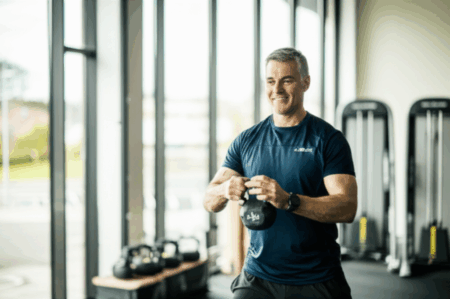A new analysis of existing studies reveals that muscular strength and good physical fitness are significantly linked to a lower risk of death in people diagnosed with cancer. The findings, published in the British Journal of Sports Medicine, suggest that incorporating tailored exercise programs to boost muscle strength and cardiorespiratory fitness could improve survival rates for cancer patients.
The Impact of Fitness on Cancer Mortality
The comprehensive analysis pooled data from 42 studies, involving nearly 47,000 cancer patients. Researchers examined the association between muscle strength, measured by handgrip strength, and cardiorespiratory fitness, assessed through cardiopulmonary exercise testing or the 6-minute walk test, and the risk of death from any cause, as well as specifically from cancer. The results showed a clear correlation: patients with greater muscle strength and higher cardiorespiratory fitness had a significantly reduced risk of mortality.
Compared to individuals with low muscle strength and poor cardiorespiratory fitness, those at the higher end of the spectrum were 31% to 46% less likely to die from any cause. Furthermore, each unit increase in muscular strength was associated with an additional 11% reduction in the risk of death. These findings highlight the importance of physical fitness in cancer prognosis.
Exercise Benefits Across Cancer Stages and Types
The positive effects of muscular strength and fitness were not limited to specific types or stages of cancer. The analysis revealed that this combination was linked to an 8% to 46% lower risk of death from any cause in patients with advanced cancers (stages 3 and 4), and a 19% to 41% lower risk among those with lung or digestive cancers. Additionally, each unit increase in fitness level was associated with an 18% lower risk of death from cancer itself.
This data underscores the potential benefits of targeted exercise programs in enhancing survival prospects across a broad spectrum of cancer patients. The researchers suggest that muscle strength could be a valuable tool in clinical practice to determine mortality risk, especially in advanced cancer stages. They further propose that muscle strengthening activities should be employed to increase life expectancy.
Why Muscle Strength Matters in Cancer Care
Muscle mass plays a vital role in overall health, and research suggests it may significantly impact a cancer patient’s prognosis. Studies indicate that good muscle mass may improve a patient’s ability to withstand the side effects of cancer treatments. In fact, muscle-building exercise is considered the most recommended treatment for cancer cachexia, a muscle-wasting condition affecting a large percentage of cancer patients and contributing to a significant number of cancer-related deaths.
Strength training not only increases muscle mass but also improves balance, reduces fatigue, and enhances the ability to perform daily activities. This can be achieved through various methods, including hand weights, exercise machines, resistance bands, or bodyweight exercises. Building muscle after cancer treatment is beneficial as well, helping to maintain muscle strength, decreasing the risk of cancer recurrence, and improving the quality of life after cancer.
The Power of Exercise: Aerobic and Resistance Training
A well-rounded exercise program, including both strength training and aerobic exercise, is recommended for cancer patients. Aerobic exercises, such as walking, cycling, or swimming, improve cardiovascular health and stamina by increasing heart and breathing rates. This enhances the body’s ability to use oxygen, which is essential for maintaining energy levels during cancer treatment.
Resistance exercises, like weight lifting, significantly increase muscle strength and endurance. These activities improve muscle mass, quality, and functional capacity, making everyday activities easier to manage. For breast cancer patients, strength training can counteract muscle loss caused by chemotherapy and improve upper body strength, particularly beneficial after surgery. Similarly, prostate cancer patients can benefit from resistance exercises that manage muscle loss and weight gain associated with hormone therapy.
Exercise Recommendations for Cancer Patients
Several organizations, including the American Cancer Society and the Clinical Oncology Society of Australia, recommend regular physical activity for cancer patients. These guidelines emphasize avoiding inactivity and returning to normal activities as soon as possible after diagnosis and treatment. The general recommendations include:
- Aim for 150-300 minutes of moderate intensity activity or 75-150 minutes of vigorous intensity activity each week.
- Include resistance training exercises at least two days per week.
- Incorporate stretching exercises at least two days each week.
Exercise should be tailored to the individual’s cancer type, stage, and any side effects they may experience. It is essential to consult an exercise professional or healthcare provider to develop a safe and effective program.
Exercise Beyond Cancer: Benefits for Overall Health
The benefits of physical activity extend far beyond cancer care. Exercise reduces the risk of various chronic conditions, including cardiovascular disease, type 2 diabetes, and some types of cancer. Regular exercise helps manage weight, regulates hormones, and strengthens the immune system.
Furthermore, studies show that even short bursts of moderate to vigorous activity can significantly reduce the risk of cardiovascular events and lower the risk of all-cause mortality. The stronger the heart, the more efficiently it pumps blood, contributing to overall health and longevity.
The Crucial Role of Cardiorespiratory Fitness
Cardiorespiratory fitness is a strong predictor of health outcomes and plays a crucial role in reducing mortality risk. A study published in the British Journal of Sports Medicine found that for every additional 1-MET (metabolic equivalent of task) exerted through aerobic exercise, the risk of all-cause death decreased by 11% to 17%, and the risk of heart failure reduced by up to 18%.
These findings emphasize the importance of engaging in regular aerobic exercise to enhance cardiorespiratory fitness and promote overall health. Combining aerobic exercise with muscle-strengthening activities offers the most significant benefits for reducing mortality risk.
The Future of Exercise in Cancer Treatment
As research continues to reveal the profound benefits of exercise for cancer patients, it’s becoming increasingly clear that physical activity should be a standard part of cancer care. The focus is shifting towards personalized exercise programs that address the specific needs of each patient, from managing treatment side effects to improving long-term survival.
Healthcare providers are urged to encourage cancer patients to be as physically active as possible throughout their cancer journey. Incorporating muscular strength and cardiorespiratory fitness into treatment plans can lead to improved outcomes, better quality of life, and increased survival rates. The evidence is clear: exercise is not just an optional activity but a powerful tool in the fight against cancer.







